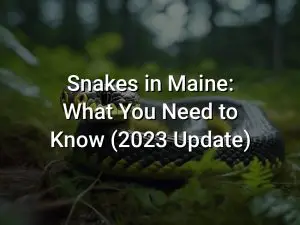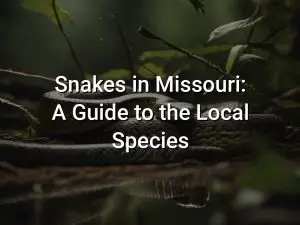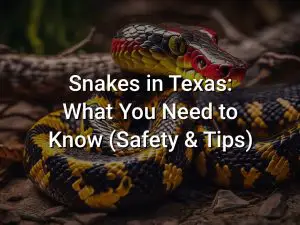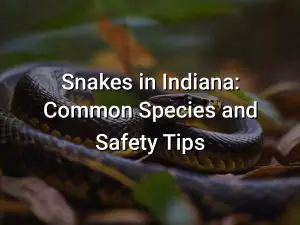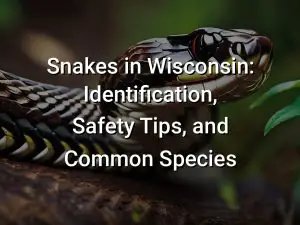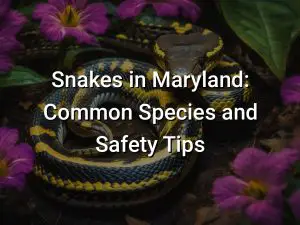Snakes in Minnesota: Species, Identification, and Safety Tips

Snakes in Minnesota may not be the first thing that comes to mind when you think of the Land of 10,000 Lakes, but these slithering creatures are actually quite prevalent in the state. From the harmless Garter Snake to the venomous Timber Rattlesnake, Minnesota is home to a variety of snake species.
In this article, we’ll explore the different snake species found in Minnesota, provide tips for identification, and offer safety tips to help you navigate encounters with these fascinating reptiles. So buckle up, snake lovers, and get ready to learn all about the snakes of Minnesota!
Quick Links
Garter Snake
The garter snake is one of the most common snake species found in Minnesota. It is a non-venomous snake with a long, slender body and distinctive stripes running along its back. The garter snake can vary in color, ranging from green, brown, and black to red or yellow, and its belly is usually lighter in color.
These snakes are typically found in a variety of habitats, including woodlands, prairies, wetlands, and gardens. They are active during the day, especially during warm weather, and can often be seen basking in the sun or hunting for food.
Garter snakes primarily feed on insects, earthworms, slugs, and small amphibians. They play a beneficial role in controlling pest populations, making them a welcome presence in gardens and yards.
While garter snakes are generally harmless to humans, they may still bite if provoked or threatened. However, their bite is usually not painful or dangerous, and they are more likely to flee than confront a perceived threat.
If you encounter a garter snake, it is best to observe it from a distance and avoid any sudden movements. These snakes are beneficial to the environment and should be respected and appreciated for their role in the ecosystem.
Rat Snake
The Rat Snake is a common snake species found in Minnesota. They are non-venomous and are known for their ability to climb trees and swim. Rat snakes can grow up to 6 feet in length and have a slender body with smooth scales.
These snakes are excellent climbers and are often found in trees, where they search for bird eggs and small mammals as their primary food source. They are also known to be skilled swimmers and can often be found near water sources.
Rat snakes have a distinct pattern on their bodies, with light brown or grayish scales and dark brown or black blotches. The blotches on their bodies are usually thicker towards the head and become smaller and more irregular towards the tail.
When threatened, Rat Snakes will usually try to escape rather than defend themselves. They may flatten their bodies to appear larger and hiss as a warning sign. However, they are not aggressive snakes and rarely bite humans unless provoked or handled improperly.
If you encounter a Rat Snake in Minnesota, it is best to observe it from a safe distance and let it go about its business. Remember that these snakes play an important role in controlling rodent populations and are beneficial to the ecosystem.
If you have concerns about snakes in your area or need assistance with identification, it is best to contact your local wildlife authorities or a professional snake removal service for guidance.
Fox Snake
The Fox Snake is a non-venomous snake species that is native to Minnesota. It is known for its resemblance to the more dangerous Massasauga Rattlesnake, but it poses no threat to humans. Fox Snakes can grow up to 4 feet in length and have a distinctive pattern of dark blotches on a light background.
These snakes are primarily found in prairie habitats, but they can also be found in open woodlands and wetlands. They are excellent swimmers and climbers. Fox Snakes are diurnal, which means they are most active during the day.
When threatened, Fox Snakes may flatten their bodies and vibrate their tails, mimicking the behavior of a rattlesnake. They may also emit a foul-smelling musk as a defense mechanism. Despite these behaviors, Fox Snakes are harmless and prefer to avoid human interaction.
Fox Snakes primarily feed on small mammals, birds, and amphibians. They are an important part of the ecosystem as they help control populations of rodents and other small animals.
If you encounter a Fox Snake in the wild, it is best to observe from a distance and not attempt to handle or disturb it. Snakes play a crucial role in maintaining a balanced ecosystem, and it is important to respect their presence in their natural habitats.
Water Snake
Water snakes are a common species of snake found in Minnesota. They are most commonly found near bodies of water such as lakes, ponds, and streams. Water snakes are nonvenomous and are often mistaken for other venomous snakes such as the cottonmouth or copperhead due to their similar appearance.
The water snake is a thick-bodied snake with a dark brown or black coloration. It has a pattern of dark bands or blotches along its body and a lighter-colored belly. The head of the water snake is usually wider than the neck, and it has round eyes with vertical pupils.
Water snakes are excellent swimmers and are often seen basking on rocks or tree branches near the water’s edge. They feed on a diet of fish, amphibians, and small mammals. Water snakes are important for controlling populations of prey species and maintaining the balance of aquatic ecosystems.
If you encounter a water snake in Minnesota, it is important to remember that they are nonvenomous and generally not aggressive towards humans. However, it is best to keep a safe distance and not attempt to handle or disturb them. Water snakes will typically retreat into the water if they feel threatened.
It is always important to be cautious when encountering any snake in the wild. If you are unsure of the species or behavior of a snake, it is best to leave it alone and observe from a safe distance. If you have concerns about snakes on your property, it is recommended to contact a professional wildlife management service to safely remove them.
Green Snake
The green snake, also known as the smooth green snake, is a non-venomous snake species that is native to Minnesota. As its name suggests, this snake has a vibrant green coloration, which helps it blend in with its surroundings, such as grassy areas and vegetation.
The green snake is a relatively small snake, typically measuring between 12 and 20 inches in length. It has a slender body and smooth scales, giving it an elegant appearance. Due to its small size and gentle nature, the green snake is often overlooked and mistaken for other snake species.
In terms of behavior, the green snake is primarily diurnal, meaning it is active during the day. It feeds on a diet consisting mostly of insects, spiders, and small invertebrates. It is also known to occasionally consume small amphibians and reptiles.
The green snake is a harmless species and poses no threat to humans. It is shy and non-aggressive, preferring to flee or hide rather than confront any potential threats. If encountered, it is best to observe and appreciate the beauty of the green snake from a distance.
It’s important to note that while the green snake is not venomous, there are venomous snake species in Minnesota, such as the timber rattlesnake and the massasauga. It’s essential to be able to identify different snake species and understand safety tips for encountering snakes in the wild. By being educated and taking necessary precautions, you can safely coexist with Minnesota’s snake species.
Eastern Milk Snake
The Eastern Milk Snake (Lampropeltis triangulum) is a harmless snake species found in Minnesota. It is known for its colorful appearance, which often resembles the patterns of venomous snakes. However, the Eastern Milk Snake is non-venomous and poses no threat to humans.
Identification:
- The Eastern Milk Snake has a slender body that can grow up to 4 feet in length.
- It has smooth scales and a distinct pattern of reddish-brown or grayish-brown blotches outlined in black, running down its back.
- Its belly is usually a lighter shade of gray or white, with black markings.
- The head of the Eastern Milk Snake is slightly wider than its body and has a rounded snout.
Habitat and Behavior:
The Eastern Milk Snake is primarily found in wooded areas, grasslands, and along the edges of forests. It prefers habitats with a good supply of rodents and other small prey.
- It is a secretive snake species and prefers to hide under logs, rocks, or in crevices.
- Eastern Milk Snakes are most active at night, but they may also be seen basking in the sun during the day.
- They are excellent climbers and often found in trees or shrubs.
Diet:
The Eastern Milk Snake is a constrictor and feeds primarily on small mammals such as mice, voles, and shrews.
Safety Tips:
- Do not attempt to handle or provoke the Eastern Milk Snake or any other wild snake species.
- If encountered, give the snake space and observe it from a safe distance.
- Keep your yard free from debris that can provide hiding spots for snakes.
- Never kill or harm snakes, as they play an important role in controlling rodent populations.
- If you have concerns about snakes on your property, contact a professional wildlife removal service for assistance.
Remember, the Eastern Milk Snake is non-venomous and beneficial to the ecosystem, so there is no need to fear or harm these snakes if encountered in the wild or in your surroundings.
Timber Rattlesnake
The Timber Rattlesnake (Crotalus horridus) is one of the venomous snake species found in Minnesota. It is a pit viper known for its distinct rattle, which it uses as a warning signal when threatened. The Timber Rattlesnake is characterized by its large, stocky body, triangular-shaped head, and distinctive dark brown or black scales with light-colored bands.
These snakes are mostly found in southeastern Minnesota, particularly in forested areas with rocky outcrops, cliffs, and bluffs. They are often found near water sources, such as rivers, streams, and marshlands. Timber Rattlesnakes are ambush predators that primarily feed on small mammals, such as mice, rats, and squirrels.
Timber Rattlesnakes are generally not aggressive and will only strike when provoked or threatened. It is important to be cautious and give these snakes a wide berth if encountered in the wild. If you come across a Timber Rattlesnake, it is best to slowly and calmly back away to avoid any potential conflicts.
If you are bitten by a Timber Rattlesnake, seek immediate medical attention. Remember to stay calm and immobilize the affected area, as moving can cause the venom to spread more quickly. Do not attempt to suck out the venom or apply a tourniquet, as these methods are ineffective and can cause further harm.
It’s important to note that the Timber Rattlesnake is a protected species in Minnesota due to its declining population. It is illegal to harm, kill, or possess these snakes without a special permit. If you encounter a Timber Rattlesnake in the wild, observe it from a safe distance and appreciate its role in the local ecosystem.
Massasauga
The Massasauga is a venomous snake species found in Minnesota. It is a small rattlesnake characterized by its distinctive rattle at the end of its tail. The Massasauga is a pit viper, meaning it has heat-sensing pits on its head that it uses to detect prey.
Massasaugas are typically found in wetland areas, such as marshes, swamps, and damp meadows. They prefer areas with dense vegetation and cover, where they can hide and ambush their prey. Their diet consists mainly of small mammals, such as mice and voles.
Identifying features of the Massasauga include a gray or brown body with dark brown blotches or bands, a triangular-shaped head, and vertical pupils. Adult Massasaugas can reach lengths of up to 30 inches.
If you encounter a Massasauga in the wild, it is important to maintain a safe distance and avoid provoking or handling the snake. Massasaugas will typically only bite if they feel threatened or cornered. Its venom is potent and can cause pain, swelling, and other symptoms.
If you suspect you have been bitten by a Massasauga, it is important to seek immediate medical attention. Anti-venom is available for treatment, and prompt medical intervention can help minimize the effects of the snakebite. Remember to stay calm and immobilize the affected area until you can receive proper medical care.
When spending time in areas where Massasaugas are known to inhabit, it is advisable to wear sturdy footwear, stay on designated paths, and avoid reaching into areas where you cannot see clearly. Being cautious and aware of your surroundings can go a long way in preventing snake encounters and ensuring your safety.
Western Hognose Snake
The Western Hognose Snake is a unique and fascinating species found in Minnesota. It is known for its distinctive upturned snout and triangular-shaped head. The snake gets its name from its habit of flattening its head and hissing loudly when threatened, resembling the behavior of a venomous snake.
Despite its intimidating behavior, the Western Hognose Snake is harmless to humans. It primarily feeds on small vertebrates such as rodents, frogs, and toads. This snake plays an important role in controlling rodent populations, making it beneficial to have around.
The Western Hognose Snake is generally found in open prairies, sandy areas, and grasslands. It is well adapted to these habitats, with its coloration and pattern providing excellent camouflage. The snake can vary in color, ranging from yellow to brown, but they often have dark blotches or patterns running along their bodies.
If you come across a Western Hognose Snake in the wild, it is best to observe it from a safe distance. Like all snakes, it is important to respect their space and not disturb them. These snakes are typically docile and will try to retreat rather than engage in confrontation.
It is important to note that the Western Hognose Snake is a species of special concern in Minnesota, meaning it is considered vulnerable and in need of conservation efforts. If you encounter one, consider yourself lucky to witness this unique snake in its natural habitat.
Eastern Hog-nosed Snake
The Eastern Hog-nosed Snake is a unique and fascinating snake species found in Minnesota. It is known for its distinctive upturned snout, which gives it the appearance of a pig’s nose. This snake is non-venomous and harmless to humans.
Eastern Hog-nosed Snakes are medium-sized snakes, typically ranging from 20 to 40 inches in length. They have a variety of color patterns, with some individuals having solid colors and others displaying intricate patterns of dark blotches and striping. Their coloration can range from gray or brown to vibrant yellows, oranges, and reds.
One of the most interesting behaviors of the Eastern Hog-nosed Snake is its defensive display. When threatened, it may flatten its head, hiss loudly, and strike with its mouth closed. If these bluffing displays do not deter a potential predator, the snake may resort to playing dead. It will roll onto its back, convulse, emit a foul odor, and even regurgitate its last meal to further convince the threat that it is not a viable meal.
The diet of the Eastern Hog-nosed Snake consists mainly of amphibians, frogs, toads, and small reptiles. It has specialized rear fangs that are used to inject mild venom into its prey, helping to subdue and digest its meals. However, this venom is harmless to humans and poses no threat.
Eastern Hog-nosed Snakes prefer sandy or loose soil habitats, such as prairies, savannas, and woodlands. They are often found in areas with sandy soil, as it provides them with the perfect environment for burrowing and hunting for their prey.
When encountering an Eastern Hog-nosed Snake in the wild, it is important to remember that they are harmless and play a crucial role in the ecosystem as predators of small animals. Appreciating their unique appearance and behaviors from a safe distance is the best approach.
If you come across an Eastern Hog-nosed Snake, it is best to observe it from a distance and avoid disturbing it. These snakes are beneficial to the environment and should be respected and protected.
- Do not attempt to handle or capture an Eastern Hog-nosed Snake.
- Keep a safe distance and allow the snake to continue on its way.
- If you encounter a snake in your yard or near your home, contact a local wildlife expert or snake removal service for assistance.
- Remember, snakes are an important part of the ecosystem and help control populations of small animals.
By understanding and respecting the Eastern Hog-nosed Snake and other snake species, we can coexist peacefully with these fascinating creatures and contribute to the conservation of Minnesota’s rich biodiversity.
Conclusion
Snakes can be found in various parts of Minnesota, and it’s important to be able to identify the different species to ensure your safety and the safety of the snakes. While most snakes in Minnesota are harmless and play a crucial role in the ecosystem, there are a few venomous species to be aware of, such as the Timber Rattlesnake and the Massasauga. It’s best to keep a safe distance if you encounter any snake in the wild and avoid provoking or handling them.
Remember, snakes are an essential part of our ecosystem and should be respected. If you live in an area where snakes are common, take precautions to minimize any potential conflicts. Keep your yard clean and free of debris, which can attract snakes and their prey. If you encounter a snake in your home or yard and are unsure of its species, it’s best to contact a professional for assistance. By understanding the different species and following safety tips, you can coexist with snakes in Minnesota and appreciate the important role they play in our environment.

